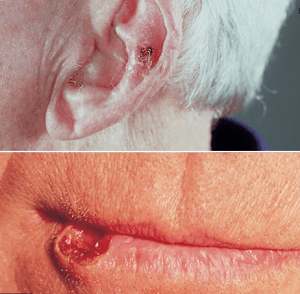types-of-skin-cancer

Skin cancer — the abnormal growth of skin cells — most often develops on skin exposed to the sun. But this common form of cancer can also occur on areas of your skin not ordinarily exposed to sunlight. There are three major types of skin cancer — basal cell carcinoma, squamous cell carcinoma, and melanoma.
You can reduce your risk of skin cancer by limiting or avoiding exposure to ultraviolet (UV) radiation. Checking your skin for suspicious changes can help detect skin cancer at its earliest stages. Early detection of skin cancer gives you the greatest chance for successful skin cancer treatment.
Skin cancer develops primarily on areas of sun-exposed skin, including the scalp, face, lips, ears, neck, chest, arms and hands, and on the legs in women. But it can also form on areas that rarely see the light of day — your palms, beneath your fingernails or toenails, and your genital area.
The three main types of Cancer
✔ Basal cell carcinomas are the most frequent, yet least aggressive skin cancer form, typically developing on areas regularly exposed to the sun including your face, ears, neck, scalp, shoulders, or back. Basal Cell Carcinomas appear as a shiny bump, open sore, reddish patch or pink growth. They remain in one area and do not spread Treatment involves a one-time treatment to surgically remove the infected area.
✔ A more aggressive form is known as Squamous Cell Carcinoma. These are more aggressive than basal cell carcinoma and may result from excessive sun exposure or exposure to carcinogenic chemicals. These do have the ability to spread to other areas of the body such as the lymph glands. Spreading typically occurs if the cancer is larger or has been growing, untreated, for a long period of time. Treatment involves surgery to remove cancer and close monitoring of the lymph glands in the area.
✔ Melanoma is the most aggressive form of skin cancer, but also the least common. If not detected early, melanoma may spread to the surrounding lymph glands or other organs. To treat melanoma, the affected skin needs to be surgically removed, along with a rim of normal skin surrounding the infected area. Tests, including a chest x-ray, blood test, the sampling of lymph glands, and CT scans may also be performed to ensure that cancer has not spread elsewhere. A best practice is to continue to monitor the patient to ensure the Cancer does not return over the coming years.
How do identify a cancerous spot?
It is important that you get to know your skin and inspect it regularly. It is even more important that you have regular skin cancer checks performed by a professional at a skin cancer clinic. When you inspect regularly you will have a solid understanding of what is normal for your skin; you will be aware of where your blemishes and spots are and can monitor them for any changes in size, color, and texture. It is important to note that skin cancers are rarely painful and are most commonly seen before they are felt.
